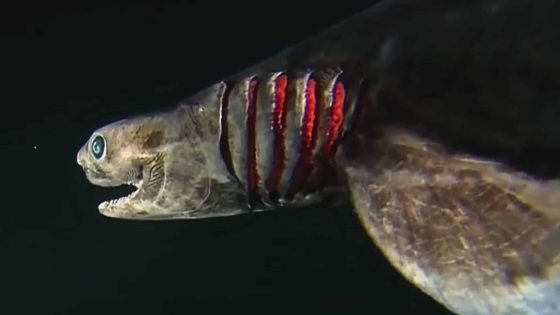Scientists recently made a remarkable discovery off Portugal‘s coast when a frilled shark, a species unchanged for 80 million years, was caught in a fishing net. This ancient predator offers a rare glimpse into the deep ocean’s mysteries. How often do we encounter creatures that have survived since the time of dinosaurs?
- Frilled shark is a "living fossil."
- Rarely seen in natural habitat.
- Uses ambush strategy for hunting.
- Longest gestation period among vertebrates.
- Increased fishing raises conservation concerns.
- Deep-sea research is critically needed.
Frilled Shark Discovery: A Living Fossil from the Depths of the Ocean
What does it mean to find a creature that has existed for millions of years? The frilled shark, measuring 1.5 meters, was pulled from depths of 700 meters during a research project aimed at reducing bycatch. This discovery emphasizes the need for further exploration of our oceans. Are we truly aware of the ancient species lurking beneath the waves?
Understanding the Frilled Shark’s Unique Adaptations and Behavior
The frilled shark’s unique features make it a fascinating subject for research. With its eel-like body and flexible jaw, it employs an ambush strategy to hunt fish and squid in the dark depths. Here are some key characteristics:
- 300 needle-like teeth for trapping prey.
- Ambush predator, relying on stealth rather than speed.
- One of the longest gestation periods of any vertebrate—up to 3.5 years.
- Slow reproductive rate, making it vulnerable to environmental changes.
Why Are Frilled Sharks Rarely Seen Alive?
Despite their global presence, frilled sharks are seldom observed in their natural habitat. They typically dwell between 500 and 1,000 meters deep, making encounters extremely rare. The last known live capture was in Australia in 2007, but that shark did not survive long after being brought to the surface. Why do these elusive creatures only surface under duress?
Conservation Concerns for the Frilled Shark
While the International Union for Conservation of Nature does not classify the frilled shark as endangered, the rise in deep-sea fishing raises alarms. These sharks reproduce slowly and inhabit unexplored ocean regions, increasing their vulnerability. What can we do to protect these ancient predators as human activities expand into the deep sea?
In conclusion, the frilled shark serves as a reminder of the ocean’s hidden wonders. As we continue to explore and exploit these depths, we must prioritize the conservation of such extraordinary species. Will we take the necessary steps to ensure their survival?

































